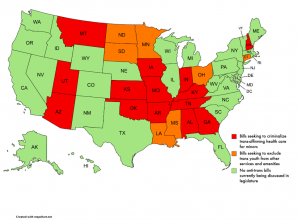Part One; Part Two; Part Three

Quick reminder: I am not trans, and there are trans authors you can read all over the place. They are, naturally, more authoritative sources on trans identity and experience. I’m reminded of this especially in this post, because I’m going to do something that makes me a little nervous: advance of a theory of where trans identities come from.
I’m nervous about this for a couple reasons. One is that, if my speculations are 1. seriously wrong and 2. get a lot of support for some reason, that could hurt trans people. Another is that there’s something, at best, indelicate about advancing theories about other people’s sense of self, when you don’t have to pay any of the costs they do. (1) I offer these speculations because they might be helpful for people trying to learn about trans issues, and because I don’t think they could be used to hurt trans people.
Our brains have a ‘map’ of our bodies built into the nervous system, which is you know what your hands are doing when you can’t see them. This map, and the system of sensors that make it work, is called proprioception. It’s this that not only gives us an idea of our movements and posture, but also contributes to things like phantom limb syndrome—a person who’s had to have a body part amputated continues feeling things, including pains, ‘in’ the missing part. Proprioception, the map, hasn’t changed, but the thing it’s mapping has.
So suppose that, somehow, a person’s proprioception is shaped as one gender, while their anatomy is shaped as the other: sort of a neurological intersex, I guess. Wouldn’t that probably look just like the experience trans people so often describe?
And this is not pure speculation. One study, done in 2008, investigated a possible link between proprioception and transgender identities. It suggests that trans men (2) have phantom sensations of male genitals as often as 60% of the time. Similarly, trans women who receive a penectomy (3) have phantom genital sensations only half as often as cisgender men who have a penectomy. This isn’t conclusive: it’s one study, and at most it establishes a link, not a one-to-one relationship of cause and effect. (Science is hard.) Nor does it clearly cover every trans person’s experience. But it’s an interesting possibility for further research.
(1) Wherever might I have learned that.
(2) I.e., apparently female anatomy with a male gender identity. Conversely, trans women are born with apparently male anatomy and identify as female.
(3) Surgical removal of the penis. Usually this is done for health reasons, e.g. to prevent the spread of cancer cells.
Images via Pixabay












